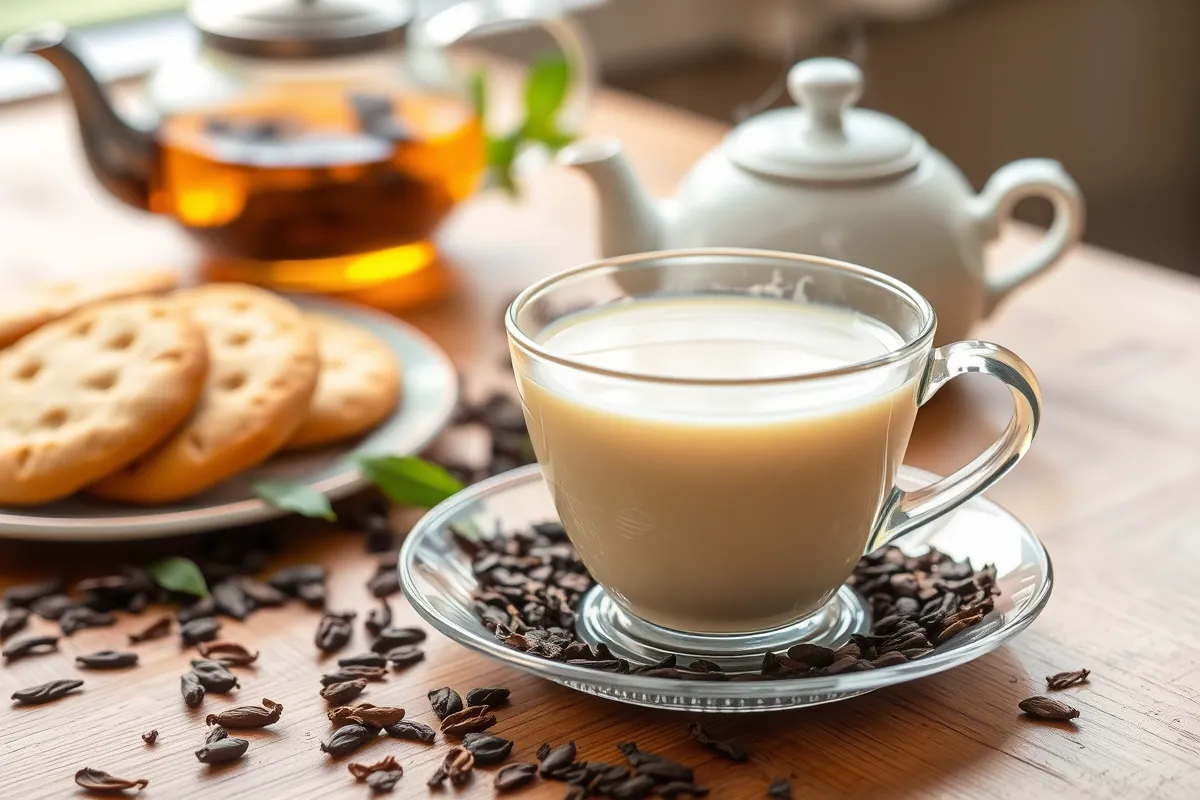There’s something truly timeless and universally comforting about enjoying a warm cup of English Breakfast Tea with milk. This classic morning brew seamlessly blends a robust, bold flavor with a creamy smoothness, making it a cherished favorite for countless tea enthusiasts. However, have you ever paused to wonder about its fascinating history, the secrets to preparing it perfectly, or the ideal foods to pair with this delightful beverage? In this article, we will delve deeply into every intriguing detail about English Breakfast Tea with milk, starting with its rich and storied heritage. Furthermore, we will provide expert brewing tips, discuss the impressive health benefits, and suggest the most complementary accompaniments. So, grab your favorite teacup, settle in, and let’s embark on this flavorful journey together!
What Is English Breakfast Tea with Milk?
A Classic Combination
At its heart, English Breakfast Tea with milk is a harmonious blend of bold black teas, often including Assam, Ceylon, and Kenyan varieties, combined with the creamy richness of milk. This classic pairing not only enhances the tea’s robust flavor but also provides a perfect balance by softening its strength with a velvety, smooth texture. Traditionally served piping hot, this beloved beverage holds a significant place in British tea culture, where it is cherished as a daily ritual. Moreover, its popularity has transcended borders, making it a timeless global favorite enjoyed in countless homes and cafés around the world.
Why Is Milk Added to Tea?
Historically, milk was added to tea to prevent delicate china cups from cracking under the heat. Over time, it became a hallmark of British tea-drinking customs. Today, milk not only cools the tea but also complements its astringent notes, creating a smoother and richer taste.
Global Appeal and Adaptations
Though deeply rooted in British traditions, this combination has spread worldwide. Variations exist based on regional preferences, with dairy-free alternatives like oat milk or almond milk becoming popular for a modern twist.
The Flavor Profile
The hallmark of English Breakfast Tea is its full-bodied flavor, characterized by malty, bold, and slightly bitter undertones. Adding milk softens the tannins and introduces a creamy sweetness, making it an ideal companion to breakfast or afternoon snacks.
History and Evolution
The Origins of English Breakfast Tea
The story of English Breakfast Tea begins in the early 19th century, when tea was cementing its place as the quintessential British beverage. Though tea drinking had been popular for centuries, the concept of a robust blend for breakfast emerged later. Robert Drysdale, a Scottish tea merchant, is often credited with creating the first English Breakfast Tea blend.
Drysdale skillfully crafted a combination of strong black teas specifically designed to pair perfectly with hearty and satisfying morning meals. His original blend included Assam, celebrated for its malty, bold profile, and Ceylon, which contributed a bright, citrusy note that added a refreshing dimension. As the tea gained traction, not only in Britain but also across the globe, it quickly became a household favorite. Over time, other tea merchants began experimenting with the blend to enhance its richness, incorporating Kenyan tea to provide added depth, balance, and complexity. Today, the term “English Breakfast Tea” has become synonymous with a strong, full-bodied black tea blend that remains a staple in morning routines worldwide.
The global spread of this tea was also fueled by the British Empire’s expansive trade routes. Its versatility, boldness, and compatibility with milk and sugar solidified its popularity, making it a morning staple worldwide.
How Milk Became a Staple in English Tea Culture
Adding milk to tea is more than a culinary choice—it’s steeped in tradition. This practice started in 17th-century Britain, when people favored delicate porcelain cups. Pouring hot tea directly into these cups often cracked the fragile material, so they added milk first to cool the liquid.
Over time, the preference for adding milk to tea evolved beyond its original practical purpose and took on a cultural significance. What began as a way to prevent delicate porcelain teacups from cracking under the heat of boiling tea became associated with refinement and sophistication. This practice mirrored the aristocratic habit of tempering tea’s naturally bitter notes with the creamy smoothness of milk, creating a balanced and indulgent flavor. By the Victorian era, milk tea had solidified its place as a social and cultural staple, gracing elegant afternoon tea ceremonies. These gatherings, often accompanied by scones, finger sandwiches, and other dainty treats, elevated the act of drinking tea into a cherished tradition that endures to this day.
In contemporary times, adding milk to tea is as much about personal preference as tradition. From whole milk to plant-based alternatives, this practice adapts to modern tastes while maintaining its historic roots.
Components and Brewing Basics
Key Ingredients in English Breakfast Tea
English Breakfast Tea is a carefully crafted blend of black teas, each chosen for its unique flavor contribution. Assam tea, cultivated in India, lends a robust and malty foundation. Ceylon tea from Sri Lanka adds bright, citrusy notes, while Kenyan tea brings depth and a touch of astringency. Together, these teas create the full-bodied, rich taste that defines this iconic beverage.
When milk is added, it softens the bold flavors and complements the tea’s tannins, resulting in a creamy, satisfying cup. Whole milk remains the traditional choice, but modern palates often opt for plant-based alternatives like oat, almond, or soy milk, each adding its distinct twist. For example, oat milk provides a neutral creaminess, while almond milk introduces a subtle nutty flavor.
Brewing the Perfect Cup
To brew the ideal cup of English Breakfast Tea with milk, precision and proper technique are key to achieving a perfectly balanced flavor. To begin, choose high-quality loose-leaf tea or premium tea bags, based on your personal preference and the level of convenience you desire. After selecting your tea, prepare freshly boiled filtered water, as this ensures both purity and a cleaner flavor that enhances the tea’s natural notes. Be sure to monitor the water temperature carefully, ensuring it is just below a rolling boil—around 200°F or 93°C. This step is crucial because water that is too hot can scald the tea leaves, leading to an overly bitter taste that diminishes the tea-drinking experience. By following these steps, you’ll create a delicious and aromatic cup of English Breakfast Tea with milk every time.
- Prepare your teaware: Warm the teapot or cup with hot water and discard it.
- Measure your tea: Use 1 teaspoon of loose-leaf tea or one tea bag per cup.
- Steeping: Pour hot water over the tea and let it steep for 3–5 minutes. Adjust steeping time for stronger or milder flavors.
- Add milk: Once brewed, strain the tea or remove the tea bag. Add milk slowly, tasting as you go to achieve your preferred creaminess. For dairy-free options, use warmed plant-based milk to prevent curdling.
- Optional sweeteners: If desired, stir in sugar, honey, or a sugar alternative for extra sweetness.
Consistency and balance are key. Experiment with different milk types and tea-to-water ratios to customize your perfect brew.

Benefits of English Breakfast Tea with Milk
Health Benefits of English Breakfast Tea
Beyond its comforting and familiar taste, English Breakfast Tea offers a range of impressive health benefits that make it a smart choice for daily consumption. Rich in powerful antioxidants such as flavonoids and polyphenols, it helps the body combat oxidative stress, which is a contributing factor to cellular aging and chronic diseases. Furthermore, these antioxidants are known to support heart health by promoting better circulation and reducing inflammation. Additionally, English Breakfast Tea may improve digestion by soothing the gastrointestinal system and encouraging healthy gut bacteria. With its moderate caffeine content, it provides a gentle yet effective energy boost, avoiding the jittery side effects often associated with coffee. As a result, this classic tea stands out as an ideal morning beverage for both taste and wellness.
When milk is added, the calcium content enhances bone health. However, it’s worth noting that milk can slightly reduce the bioavailability of tea’s antioxidants. Even so, the trade-off for its creamy texture and delightful taste often feels worth it to avid tea drinkers.
Comparing Dairy and Non-Dairy Options
The choice between dairy and plant-based milk significantly impacts both nutrition and flavor. Whole milk is high in calcium and protein, complementing the tea’s robustness. Skim milk offers fewer calories but retains much of the creamy texture.
For those avoiding dairy, plant-based options like oat milk and almond milk are excellent substitutes. Oat milk provides a neutral creaminess, while almond milk adds a nutty hint. Soy milk, another favorite, has a bold profile that pairs well with strong tea. Nutritionally, these alternatives vary; for instance, almond milk is lower in calories, while oat milk has a higher carbohydrate content.
Finding the right milk depends on personal preference, dietary needs, and how it interacts with the tea’s flavor profile. Both traditional and non-dairy choices enhance the tea-drinking experience in unique ways.
Nutritional Content of English Breakfast Tea with Milk (Per 100g)
Here’s a quick overview of the nutritional values for English Breakfast Tea with milk based on approximate estimates:
| Nutrient | Amount (Per 100g) |
|---|---|
| Calories | 20 kcal |
| Protein | 0.9 g |
| Fat | 0.7 g |
| Carbohydrates | 2.5 g |
| Sugars | 2 g |
| Calcium | 25 mg |
| Caffeine | 11 mg |
These values may vary depending on the type of milk (dairy or plant-based) and the amount added. Adjustments to milk choice can also impact calorie, fat, and carbohydrate content, making it versatile for different dietary needs.
Sustainability and Ethical Considerations
Organic and Fair-Trade Options
In recent years, the demand for sustainably sourced tea has grown, with many consumers prioritizing organic and fair-trade options. Organic English Breakfast Tea is cultivated without synthetic pesticides, herbicides, or fertilizers, which not only preserves the environment but also enhances the tea’s purity. This method supports biodiversity, reduces soil degradation, and ensures a cleaner, healthier brew.
Fair-trade certification adds another layer of ethical assurance. It guarantees that the tea is produced under equitable labor practices, providing fair wages and improving the livelihoods of tea farmers. Supporting fair-trade brands contributes to global efforts for sustainability and social equity.
Identifying Reputable Brands
When selecting organic or fair-trade teas, look for certifications like USDA Organic or Fairtrade International. Brands such as Teapigs, Harney & Sons, and Yorkshire Tea are known for their commitment to ethical sourcing. Additionally, packaging details often highlight sustainable practices, such as biodegradable tea bags or carbon-neutral operations.
By choosing these options, tea lovers can enjoy their favorite beverage while supporting a more sustainable future.
Frequently Asked Questions
Is English Breakfast Tea always served with milk?
British culture traditionally pairs English Breakfast Tea with milk. Many also enjoy it plain or enhance its flavor with alternatives like lemon or honey for a lighter touch.
What’s the best non-dairy milk for English Breakfast Tea?
Oat milk is a popular choice for its neutral creaminess, followed by almond milk for its nutty undertones. Soy milk offers a robust flavor and works well with strong tea.
Does adding milk reduce the tea’s health benefits?
Milk may slightly reduce the absorption of certain antioxidants in tea, but the overall benefits of drinking English Breakfast Tea remain significant. The creamy texture and taste often make it worth the trade-off.
Can English Breakfast Tea be iced or cold-brewed?
Absolutely! Iced English Breakfast Tea is a refreshing option, especially when paired with milk or sweeteners. Cold brewing is another great way to enjoy its robust flavor with a smoother finish.
How does the caffeine content compare to coffee?
A cup of English Breakfast Tea contains about 40–50 mg of caffeine, which is significantly lower than coffee’s 80–100 mg per cup. It offers a gentler energy boost without the jitters.
What are the best foods to pair with this tea?
Scones, biscuits, and pastries are classic companions, while savory options like finger sandwiches also pair beautifully. Toast with butter or jam is a simple yet satisfying choice.
This concludes the comprehensive guide to English Breakfast Tea with milk, from its origins to ethical sourcing and delicious pairings. Enjoy every sip responsibly and sustainably!

